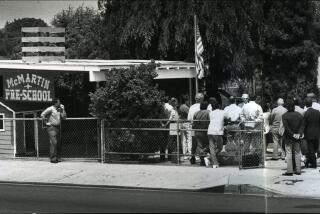A Circle of Mutually Assured Destruction
It is a trial scene worthy of Quentin Tarantino. In a courtroom in northern Virginia, many of the central characters of the Lewinsky scandal have assembled for a lethal confrontation in which every witness appears to have a gun at the head of every other witness. This circular firing squad is the result of Julie Hiatt Steele’s trial for obstruction of justice and making false statements. The first (and perhaps only) criminal case to emerge from the Lewinsky scandal, this case presents the rather bizarre situation in which virtually everyone in the courtroom will seem to be on trial. Ironically, the only central player not expected to appear is President Clinton, who may be the ultimate casualty regardless of the outcome.
First, some background. Back in March 1997, Steele was a close friend of Kathleen Willey. Willey, a volunteer at the White House, alleged that the president groped her after she asked him for a paid position to help her out of her dire financial straits. Willey’s story was supported by women who confirmed that Willey had spoken to them about the incident soon after it occurred. One of these women was Steele, who told a Newsweek reporter that Willey had confided in her and was upset after the incident.
Steele, however, would later retract the story and claim that Willey asked her to lie to support her account. Steele would later repeat this testimony under oath as part of the independent counsel investigation. Kenneth Starr’s prosecutors ultimately accepted Willey’s account and concluded that Steele was lying. Various theories emerged about pressure placed upon Steele by White House allies, including an alleged threat to look into the legal status of her adoption of a boy from Romania.
In the Virginia trial, Steele will repeat her claim that Willey is lying. Steele’s only path out of the courtroom is over the discredited body of Willey. Willey in turn is expected to charge Steele with lying in a classic stand-off. Joining this fray will be Linda Tripp who has testified that when Willey left the Oval Office after her alleged groping, she did appear disheveled and undone. However, Tripp claims that Willey appeared to relish the encounter and was not upset as Willey claims to have been. Starr’s prosecutors will then have to neutralize Tripp as a witness.
With Starr holding off Tripp, another main witness is expected to appear: Susan McDougal. Fresh from her own acquittal for obstruction (and a hung jury on contempt), McDougal is likely to testify that Starr should be the person on trial for attempting to force false testimony. With Steele targeting Willey, Willey targeting Steele, Tripp targeting Willey, Starr targeting Tripp and McDougal targeting Starr, we are ready for the final scene.
It is Tarantino’s signature scene from “Pulp Fiction” and “Reservoir Dogs”: All of the main characters pointing guns at each others’ heads in a frozen instant of futile mutually assured destruction. Well, not all of the main characters. Missing from this melee will be President Clinton.
Ironically, Clinton may have been left out only to preserve a sequel. In the Steele and McDougal trials, Starr insisted that it was his duty to prosecute open acts of perjury and contempt. After prosecuting such minor figures as Steele for perjury, it will be difficult for Starr not to prosecute Clinton when he leaves office. After all, while Steele has a strong defense, a federal judge has already concluded that Clinton intentionally lied under oath when she held him in contempt of court. The statute of limitations on perjury and obstruction is five years, which means that the president can be charged at any time before 2003. The Steele trial certainly makes such an indictment appear more likely. Starr has already testified that he believes the president to be guilty of false testimony and obstruction of justice, referred grounds of high crimes and misdemeanors to Congress for the president’s impeachment, and charged average citizens in less compelling cases. At this point, if he does not charge the president, Starr will look as if he spent most of his time in court shooting the wounded and pursuing the lame.
As all of the characters fall on cue in Virginia, we will be left with the quintessential Tarantino moment where none of the characters appeared inspiring except in their fateful commitment at the final scene. Perhaps, this is a scandal that only Tarantino could direct.
More to Read
Only good movies
Get the Indie Focus newsletter, Mark Olsen's weekly guide to the world of cinema.
You may occasionally receive promotional content from the Los Angeles Times.










